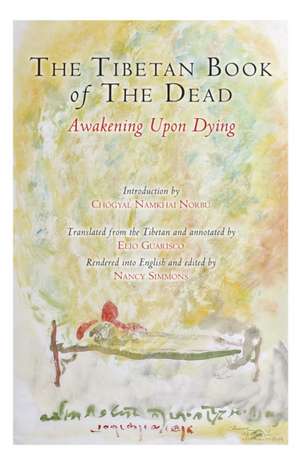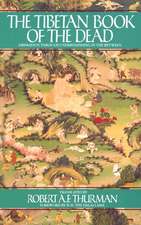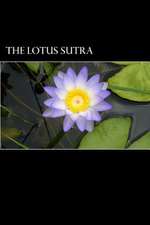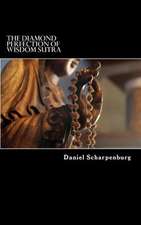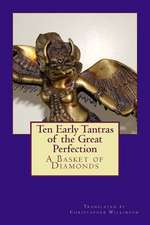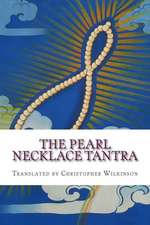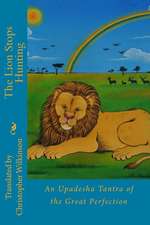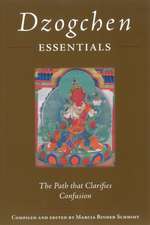The Tibetan Book of the Dead: Awakening Upon Dying
Autor Padmasambhava, Karma Lingpa, Karma-Glicn-Paen Limba Engleză Paperback – 11 mar 2013
Revealing a set of instructions designed to facilitate the inner liberation of the dead or dying person, the book provides a guide to navigating the bardo--the interval between death and rebirth. Originally composed by Padmasambhava, an important Indian master of the eighth century, the Tibetan Book of the Dead was concealed in Tibet until it was discovered in the fourteenth century by Karma Lingpa, a famous Tibetan tertön (discoverer of ancient texts). Describing in detail the characteristics and fantastic visions of each stage beyond death, the book includes invocations to be read aloud to the dying person, to help his or her successful journey toward the stage of liberation.
Chögyal Namkhai Norbu's introduction clarifies the texts from the Dzogchen point of view and provides a scholarly summary of the ancient material based on his oral teachings and written works. In addition, material from several of Namkhai Norbu's more recent written works and oral teachers have been added, including an essay on the four intermediate states after death entitled Birth, Life, and Death. A full-color 16-page insert of traditional Tibetan art highlights Tibet's unique aesthetic wisdom.
Preț: 92.62 lei
Preț vechi: 109.15 lei
-15% Nou
Puncte Express: 139
Preț estimativ în valută:
17.72€ • 19.31$ • 14.93£
17.72€ • 19.31$ • 14.93£
Carte disponibilă
Livrare economică 02-09 aprilie
Livrare express 19-25 martie pentru 46.11 lei
Preluare comenzi: 021 569.72.76
Specificații
ISBN-13: 9781583945551
ISBN-10: 1583945555
Pagini: 320
Ilustrații: 16-PAGE 4-COLOR INSERT 4 B&W ILLUSTRATIONS
Dimensiuni: 140 x 216 x 23 mm
Greutate: 0.48 kg
Editura: NORTH ATLANTIC BOOKS
ISBN-10: 1583945555
Pagini: 320
Ilustrații: 16-PAGE 4-COLOR INSERT 4 B&W ILLUSTRATIONS
Dimensiuni: 140 x 216 x 23 mm
Greutate: 0.48 kg
Editura: NORTH ATLANTIC BOOKS
Notă biografică
Padmasambhava was a Tibetan master from the eighth century who introduced the Buddhist teachings to Tibet. He is considered the author of several sacred texts that were hidden and rediscovered several centuries later by accomplished practitioners called tertons (discoverers of ancient texts).
A famous Tibetan terton from the fourteenth century, Karma Lingpa was a meditation master who discovered the ancient texts of the Tibetan Book of the Dead that had been hidden centuries before by Padmasambhava.
Born in Eastern Tibet in 1938, Chögyal Namkhai Norbu is an internationally known Dzogchen Buddhist teacher and author. He is the founder of two nonprofit organizations including the Shang Shung Institute for Tibetan Studies, which is dedicated to the preservation of Tibetan culture.
Elio Guarisco received a Master of Arts degree in Italy before traveling to India to study Buddhism. He joined the Dzogchen Community in 1986 and is a founding member of the Shang Shung Institute for Tibetan Studies.
A famous Tibetan terton from the fourteenth century, Karma Lingpa was a meditation master who discovered the ancient texts of the Tibetan Book of the Dead that had been hidden centuries before by Padmasambhava.
Born in Eastern Tibet in 1938, Chögyal Namkhai Norbu is an internationally known Dzogchen Buddhist teacher and author. He is the founder of two nonprofit organizations including the Shang Shung Institute for Tibetan Studies, which is dedicated to the preservation of Tibetan culture.
Elio Guarisco received a Master of Arts degree in Italy before traveling to India to study Buddhism. He joined the Dzogchen Community in 1986 and is a founding member of the Shang Shung Institute for Tibetan Studies.
Extras
“Awakening Upon Dying” by Chögyal Namkhai Norbu, a commentary on the Tibetan Book of The Dead
The Great Liberation through Hearing in the Intermediate States, well known in the West as The Tibetan Book of the Dead, is part of a large body of literature titled in Tibetan the Peaceful and Wrathful Deities: The Profound Teaching on Natural Liberation through Recognition of the Primordial State. Its authorship is attributed to Padmasaṃbhava, an important Indian master of the eighth century. While in Tibet, Padmasaṃbhava concealed the texts of this teaching at Mount Gampodar near the Yangtze River, where they remained as a terma or hidden treasure until the fourteenth century, when Karma Lingpa, a Tibetan youth of fifteen, brought them to light.
The Hidden Treasures
The hidden-treasure or terma tradition is a widespread phenomenon in Tibet, both in the Buddhist and in the pre-Buddhist Bönpo tradition. Hidden treasures are doctrines, texts, and sacred objects concealed by spiritual teachers in order to preserve them during future periods of plundering, devastation, religious corruption, and so on that these masters foresaw lay ahead. Subsequently, sometimes hundreds of years later at a propitious time, the terma would be discovered by a spiritually gifted individual known as a finder of hidden treasures or tertön, following indications revealed to that person in dreams, visions, or in normal waking life.
Two main kinds of hidden treasure exist: those hidden in the earth and those hidden in the mind. Earth treasures can be texts of spiritual teaching or sacred objects such as small statues, ritual instruments, relics, stones, or precious metals, and so on. Earth treasures are usually concealed underground or in rocks, caves, temple pillars, and similar places. Mind treasures, on the other hand, are spiritual teachings and instructions that emerge as natural visions from the essence of the treasure finder’s mind. These teachings are then committed to writing by the tertön himself or by a scribe, then practiced by the discoverer, and at the prescribed time, taught to others.
My academic experience in the West alerted me to the considerable mistrust with which termas are regarded by scholars. Although I recognize that forgeries certainly exist among the hidden treasures, the incidents I witnessed and the stories I heard as a youth in Tibet of the discoveries of authentic earth and mind termas inspired me with trust in these phenomena. I recount below a few examples of these remarkable findings to familiarize the reader with the hidden-treasure tradition of which so little is known in the West.
In the summer of 1952 I stayed some time with my uncle, Khyentse Chökyi Wangchug, a highly advanced spiritual practitioner, at his retreat place in Lhalung in eastern Tibet. In that period he was imparting a Dzogchen teaching to some twenty of his disciples. One day he called me to his room and recounted a dream in which he had received indications about a hidden treasure. Some weeks later, he told me that he had had another such dream, this time clearer, in which he received precise instructions for the discovery of a terma related to Vajrapâṇi. In the dream, he saw a cave; at the cave’s entrance a shadow cast by the sun striking the rocks was clearly visible in the shape of the Tibetan character ཨ (Ah). From his dream, my uncle recognized the location of the cave to be an area near a mountain that we both knew. I did my best to convince him to search for that place and to make the discovery in public, as specified in the instructions he had received, although he agreed to do so only after my long and insistent urging.
One day we set off for the place indicated in his dream, and arriving in the vicinity of the mountain, we searched the surroundings for a whole day until we succeeded in finding the cave. My uncle noted that the cave was truly identical to the one he had seen in his dream, and we felt great joy. As word of the forthcoming revelation of a terma spread, a crowd of people gathered from different parts of the region to assist at the event and, as is customary in Tibet on such occasions, to celebrate the event with songs, dances, and games. They pitched their tents and took part in propitiatory rituals to favor the discovery of the terma and eliminate the possibility of obstacles.
At dawn on the tenth day of the lunar month (July 1951), an auspicious day for Tibetans, after a long invocation my uncle remained in lengthy meditation. Then he took a pickax and hurled it with all his strength at the rock above the mouth of the cave. The pickax struck a point at a considerable height, and as that spot could not be reached unaided, local people hurriedly readied a wooden ladder. Mounting it, a monk from a nearby monastery climbed to the mark made by the pickax, where my uncle told him to begin digging. As soon as he started, he called down to say that the rock’s surface was friable. After a short while, a gleam became discernible from below. The monk said that inside the rock there seemed to be a kind of gem, and he asked my uncle whether he should remove it. My uncle told him not to touch it and requested those around him to bring a length of cloth. As about ten people held a large piece of fabric at the foot of the rock, my uncle directed the monk to let the luminous object drop onto it. To general excitement, we saw a luminous, scintillating, egg-shaped rock, turquoise in color, fall. People rushed to amass handfuls of the sacred earth that had fallen with the stone. Then began the festivities, which lasted for several days.
Another edifying example of a terma is related to the rediscovery of the seventeen upadeúa tantras, considered the core of the Dzogchen Total Perfection teaching. These seventeen tantras were taught by Vimalamitra, a great Dzogchen master, to Myang Tingdzin Zangpo, who in turn taught them to Ba Lodrö Wangchug (circa ninth century) and so on. Vimalamitra also concealed a copy of these tantras in a temple that was constructed at his behest. One hundred years later, the king Langdarma7 destroyed many Buddhist temples and monasteries, yet the devastation did not affect the transmission of the seventeen tantras that continued within the Ba family, simply from father to son, without any institutional backing. With the passing of time, however, serious doubts arose among teachers about the authenticity of these texts and the related teachings handed down in the Ba family, owing to the fact that no extant copies were available for collation, as was the norm for tantric texts. However, one day the monk serving as guardian of the temple built by Vimalamitra dreamed that a text was hidden inside a column of the temple; a few weeks later the dream recurred. He asked permission to probe inside the pillar, and searching, he discovered the seventeen upadeúa tantras, handwritten in gold letters on black paper, hidden by Vimalamitra. When the two versions were compared, only a few discrepancies with the Ba family texts were found.
Like earth termas, mind termas also enjoy vast popularity in the Tibetan spiritual milieu, especially among followers of the Nyingma, the oldest school of Tibetan Buddhism. I had a remarkable experience in this regard when I stayed a few months with rigdzin Changchub Dorje at his gar near Gojo in eastern Tibet. Among the local population, Changchub Dorje was known as an exceptionally gifted traditional doctor. Although he lived in the manner of a farmer and behaved in a simple and humble way, he was also an outstanding Dzogchen master, the discoverer of many mind termas. During my stay at his settlement, I received the transmission of one of his mind treasures titled Ocean of the Teaching, Union of Transmitted Precepts, a truly marvelous Dzogchen teaching.
Since rigdzin Changchub Dorje could hardly read and was unable to write, he dictated his revelations and a disciple would transcribe them. Knowing that, I offered to act as scribe should he have something to dictate. One day, asking me to help him with the second part of the Ocean of the Teaching, Union of Transmitted Precepts, he began to dictate that teaching, and he continued for many days until its completion. He would transmit the words of the teaching while examining patients and calming the qualms of those who came to seek his advice. As he constantly interrupted the dictation in order to speak with patients, I thought surely the resulting text would be discontinuous and fragmentary. However, in the evening, when I read what he had said to me during the day, I was dumbfounded to see that the composition was perfect both in form and style, without a single word missing, seemingly dictated without a break. Given that rigdzin Changchub Dorje was almost illiterate, this outcome was even more remarkable: no scholar, however learned, would have been able to write such an essential teaching of Dzogchen.
These examples are a glimpse into the immensely rich tradition represented by the hidden treasure teachings of Tibet, the method through which the Great Liberation through Hearing in the Intermediate States emerged in our world.
The Great Liberation through Hearing in the Intermediate States, well known in the West as The Tibetan Book of the Dead, is part of a large body of literature titled in Tibetan the Peaceful and Wrathful Deities: The Profound Teaching on Natural Liberation through Recognition of the Primordial State. Its authorship is attributed to Padmasaṃbhava, an important Indian master of the eighth century. While in Tibet, Padmasaṃbhava concealed the texts of this teaching at Mount Gampodar near the Yangtze River, where they remained as a terma or hidden treasure until the fourteenth century, when Karma Lingpa, a Tibetan youth of fifteen, brought them to light.
The Hidden Treasures
The hidden-treasure or terma tradition is a widespread phenomenon in Tibet, both in the Buddhist and in the pre-Buddhist Bönpo tradition. Hidden treasures are doctrines, texts, and sacred objects concealed by spiritual teachers in order to preserve them during future periods of plundering, devastation, religious corruption, and so on that these masters foresaw lay ahead. Subsequently, sometimes hundreds of years later at a propitious time, the terma would be discovered by a spiritually gifted individual known as a finder of hidden treasures or tertön, following indications revealed to that person in dreams, visions, or in normal waking life.
Two main kinds of hidden treasure exist: those hidden in the earth and those hidden in the mind. Earth treasures can be texts of spiritual teaching or sacred objects such as small statues, ritual instruments, relics, stones, or precious metals, and so on. Earth treasures are usually concealed underground or in rocks, caves, temple pillars, and similar places. Mind treasures, on the other hand, are spiritual teachings and instructions that emerge as natural visions from the essence of the treasure finder’s mind. These teachings are then committed to writing by the tertön himself or by a scribe, then practiced by the discoverer, and at the prescribed time, taught to others.
My academic experience in the West alerted me to the considerable mistrust with which termas are regarded by scholars. Although I recognize that forgeries certainly exist among the hidden treasures, the incidents I witnessed and the stories I heard as a youth in Tibet of the discoveries of authentic earth and mind termas inspired me with trust in these phenomena. I recount below a few examples of these remarkable findings to familiarize the reader with the hidden-treasure tradition of which so little is known in the West.
In the summer of 1952 I stayed some time with my uncle, Khyentse Chökyi Wangchug, a highly advanced spiritual practitioner, at his retreat place in Lhalung in eastern Tibet. In that period he was imparting a Dzogchen teaching to some twenty of his disciples. One day he called me to his room and recounted a dream in which he had received indications about a hidden treasure. Some weeks later, he told me that he had had another such dream, this time clearer, in which he received precise instructions for the discovery of a terma related to Vajrapâṇi. In the dream, he saw a cave; at the cave’s entrance a shadow cast by the sun striking the rocks was clearly visible in the shape of the Tibetan character ཨ (Ah). From his dream, my uncle recognized the location of the cave to be an area near a mountain that we both knew. I did my best to convince him to search for that place and to make the discovery in public, as specified in the instructions he had received, although he agreed to do so only after my long and insistent urging.
One day we set off for the place indicated in his dream, and arriving in the vicinity of the mountain, we searched the surroundings for a whole day until we succeeded in finding the cave. My uncle noted that the cave was truly identical to the one he had seen in his dream, and we felt great joy. As word of the forthcoming revelation of a terma spread, a crowd of people gathered from different parts of the region to assist at the event and, as is customary in Tibet on such occasions, to celebrate the event with songs, dances, and games. They pitched their tents and took part in propitiatory rituals to favor the discovery of the terma and eliminate the possibility of obstacles.
At dawn on the tenth day of the lunar month (July 1951), an auspicious day for Tibetans, after a long invocation my uncle remained in lengthy meditation. Then he took a pickax and hurled it with all his strength at the rock above the mouth of the cave. The pickax struck a point at a considerable height, and as that spot could not be reached unaided, local people hurriedly readied a wooden ladder. Mounting it, a monk from a nearby monastery climbed to the mark made by the pickax, where my uncle told him to begin digging. As soon as he started, he called down to say that the rock’s surface was friable. After a short while, a gleam became discernible from below. The monk said that inside the rock there seemed to be a kind of gem, and he asked my uncle whether he should remove it. My uncle told him not to touch it and requested those around him to bring a length of cloth. As about ten people held a large piece of fabric at the foot of the rock, my uncle directed the monk to let the luminous object drop onto it. To general excitement, we saw a luminous, scintillating, egg-shaped rock, turquoise in color, fall. People rushed to amass handfuls of the sacred earth that had fallen with the stone. Then began the festivities, which lasted for several days.
Another edifying example of a terma is related to the rediscovery of the seventeen upadeúa tantras, considered the core of the Dzogchen Total Perfection teaching. These seventeen tantras were taught by Vimalamitra, a great Dzogchen master, to Myang Tingdzin Zangpo, who in turn taught them to Ba Lodrö Wangchug (circa ninth century) and so on. Vimalamitra also concealed a copy of these tantras in a temple that was constructed at his behest. One hundred years later, the king Langdarma7 destroyed many Buddhist temples and monasteries, yet the devastation did not affect the transmission of the seventeen tantras that continued within the Ba family, simply from father to son, without any institutional backing. With the passing of time, however, serious doubts arose among teachers about the authenticity of these texts and the related teachings handed down in the Ba family, owing to the fact that no extant copies were available for collation, as was the norm for tantric texts. However, one day the monk serving as guardian of the temple built by Vimalamitra dreamed that a text was hidden inside a column of the temple; a few weeks later the dream recurred. He asked permission to probe inside the pillar, and searching, he discovered the seventeen upadeúa tantras, handwritten in gold letters on black paper, hidden by Vimalamitra. When the two versions were compared, only a few discrepancies with the Ba family texts were found.
Like earth termas, mind termas also enjoy vast popularity in the Tibetan spiritual milieu, especially among followers of the Nyingma, the oldest school of Tibetan Buddhism. I had a remarkable experience in this regard when I stayed a few months with rigdzin Changchub Dorje at his gar near Gojo in eastern Tibet. Among the local population, Changchub Dorje was known as an exceptionally gifted traditional doctor. Although he lived in the manner of a farmer and behaved in a simple and humble way, he was also an outstanding Dzogchen master, the discoverer of many mind termas. During my stay at his settlement, I received the transmission of one of his mind treasures titled Ocean of the Teaching, Union of Transmitted Precepts, a truly marvelous Dzogchen teaching.
Since rigdzin Changchub Dorje could hardly read and was unable to write, he dictated his revelations and a disciple would transcribe them. Knowing that, I offered to act as scribe should he have something to dictate. One day, asking me to help him with the second part of the Ocean of the Teaching, Union of Transmitted Precepts, he began to dictate that teaching, and he continued for many days until its completion. He would transmit the words of the teaching while examining patients and calming the qualms of those who came to seek his advice. As he constantly interrupted the dictation in order to speak with patients, I thought surely the resulting text would be discontinuous and fragmentary. However, in the evening, when I read what he had said to me during the day, I was dumbfounded to see that the composition was perfect both in form and style, without a single word missing, seemingly dictated without a break. Given that rigdzin Changchub Dorje was almost illiterate, this outcome was even more remarkable: no scholar, however learned, would have been able to write such an essential teaching of Dzogchen.
These examples are a glimpse into the immensely rich tradition represented by the hidden treasure teachings of Tibet, the method through which the Great Liberation through Hearing in the Intermediate States emerged in our world.
Recenzii
"This is a new inspired translation of a famed classic of Tibetan literature presented in the traditional context of the teachings of the Great Perfection (Dzogchen), which will provide practitioners precise and genuine guidance in the various Bardo states that one faces at the end of one's life. I truly admire the style and the fluidity of the rendering of the original texts. This is surely going to become an invaluable reference for all practitioners!"
—Jean-Luc Achard, director of Revue d'Etudes Tibétaines
"Known as The Great Liberation through Hearing in Tibetan, this book is a manual of instructions to guide the dying person on the difficult path at the moment of death and the deceased person in the bewildering post-mortem state, as he or she wanders in confused search for a new life. The reader first needs to awaken to the awareness that death is an ineluctable part of life. If we truly know that, our life beomes more meaningful, so that we can face death when it knocks on our door and we are prepared to use that crucial time for self-realization."
—Chögyal Namkhai Norbu, internationally known Dzogchen teacher and author
—Jean-Luc Achard, director of Revue d'Etudes Tibétaines
"Known as The Great Liberation through Hearing in Tibetan, this book is a manual of instructions to guide the dying person on the difficult path at the moment of death and the deceased person in the bewildering post-mortem state, as he or she wanders in confused search for a new life. The reader first needs to awaken to the awareness that death is an ineluctable part of life. If we truly know that, our life beomes more meaningful, so that we can face death when it knocks on our door and we are prepared to use that crucial time for self-realization."
—Chögyal Namkhai Norbu, internationally known Dzogchen teacher and author
